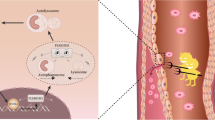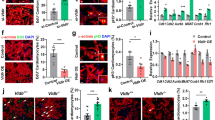Summary
Rap1 is expressed in human umbilical vein endothelial cells (HUVECs). Rap1-GTPase activating protein (Rap1GAP), with its specific target, Rap1, has been shown to be important in the regulation of many physiological and certain pathological processes. In this study, we investigated the effect of Rap1GAP expression on endothelial cell function, or, more specifically, proliferation and migration of endothelial cells. HUVECs were transfected with pcDNA3.1 (empty vector), pcDNA3.1 containing Flag-tagged-Rap1GAP or Myc-tagged-Rap1N17. The proliferation, migration and tube formation were examined and compared among the 3 groups. Expression of Rap1, Rap1GAP, extracellular signal-regulated kinase (ERK), phospho-ERK, Akt, phosphor-Akt was detected by Western blotting. The results showed that the proliferation, migration and tube formation were significantly reduced in Rap1GAP- and Rap1N17-transfected HUVECs as compared with empty vector-transfected control. These changes were coincident with increased expression of Rap1GAP and decreased expression of activated Rap1, phospho-ERK and -Akt. After treatment of Rap1GAP-transfected HUVECs with a stimulator of Rap1 guanine-nucleotide-exchange factor (Rap1GEF) 8CPT-2′OMe-cAMP, it was found that Rap1 activity was decreased as compared with empty vector-transfected control. Pretreatment of HUVECs with an ERK inhibitor PD98059 or a PI3K inhibitor LY294002 prior to stimulation not only blocked 8CPT-2′OMe-cAMP-induced phosphorylation of ERK and Akt, but also significantly reduced cell proliferation and migration. Finally, we examined the effect of vascular endothelial growth factor (VEGF) on HUVECs overexpressing Rap1GAP. VEGF-stimulated Rap1 activity, phosphorylation of ERK and Akt, cyclin D1 expression and cell proliferation were repressed in HUVECs overexpressing Rap1GAP as compared to empty vector-transfected control. Taken together, our findings demonstrate that Rap1GAP/Rap1 and their downstream effectors regulate proliferation and migration of HUVECs via ERK and Akt pathways.
Similar content being viewed by others
References
Milkiewicz M, Ispanovic E, Doyle JL, et al. Regulators of angiogenesis and strategies for their therapeutic manipulation. Int J Biochem Cell Biol, 2006,38(3):333–357
Carmeliet P. Angiogenesis in life, disease and medicine. Nature, 2005,438(7070):932–936
Takai Y, Sasaki T, Matozaki T. Small GTP-binding proteins. Physiol Rev, 2001,81(1):153–208
McLeod SJ, Shum AJ, Lee RL, et al. The Rap GTPases regulate integrin-mediated adhesion, cell spreading, actin polymerization, and Pyk2 tyrosine phosphorylation in B lymphocytes. J Biol Chem, 2004,279(13):12009–12019
Singh L, Gao Q, Kumar A, et al. The high-risk human papillomavirus type 16 E6 counters the GAP function of E6TP1 toward small Rap G proteins. J Virol, 2003,77(2): 1614–1620
Gao Q, Kumar A, Singh L, et al. Human papillomavirus E6-induced degradation of E6TP1 is mediated by E6AP ubiquitin ligase. Cancer Res, 2002,62(11):3315–3321
Kurachi H, Wada Y, Tsukamoto N, et al. Human SPA-1 gene product selectively expressed in lymphoid tissues is a specific GTPase-activating protein for Rap1 and Rap2. Segregate expression profiles from a rap1GAP gene product. J Biol Chem, 1997,272(44):28081–28088
Ishida D, Kometani K, Yang H, et al. Myeloproliferative stem cell disorders by deregulated Rap1 activation in SPA-1-deficient mice. Cancer Cell, 2003,4(1):55–65
Tsygankova OM, Feshchenko E, Klein PS, et al. Thyroid-stimulating hormone/cAMP and glycogen synthase kinase 3beta elicit opposing effects on Rap1GAP stability. J Biol Chem, 2004,279(7):5501–5507
Tsygankova OM, Prendergast GV, Puttaswamy K, et al. Downregulation of Rap1GAP contributes to Ras transformation. Mol Cell Biol, 2007,27(19):6647–6658
Nellore A, Paziana K, Ma C, et al. Loss of Rap1GAP in papillary thyroid cancer. J Clin Endocrinol Metab, 2009,94(3):1026–1032
Zhang L, Chenwei L, Mahmood R, et al. Identification of a putative tumor suppressor gene Rap1GAP in pancreatic cancer. Cancer Res, 2006,66(2):898–906
Zheng H, Gao L, Feng Y, et al. Down-regulation of Rap1GAP via promoter hypermethylation promotes melanoma cell proliferation, survival, and migration. Cancer Res, 2009,69(2):449–457
Zuo H, Gandhi M, Edreira MN, et al. Downregulation of Rap1GAP through epigenetic silencing and loss of heterozygosity promotes invasion and progression of thyroid tumors. Cancer Res, 2010,70(4):1389–1397
Tsygankova OM, Ma C, Tang W, et al. Downregulation of Rap1GAP in human tumor cells alters cell/matrix and cell/cell adhesion. Mol Cell Biol, 2010,30(13):3262–3274
Rangarajan S, Enserink JM, Kuiperij HB, et al. Cyclic AMP induces integrin-mediated cell adhesion through Epac and Rap1 upon stimulation of the β2-adrenergic receptor. J Cell Biol, 2003,160(4):487–493
de Bruyn KM, Zwartkruis FJ, de Rooij J, et al. The small GTPase Rap1 is activated by turbulence and is involved in integrin αIIbβ3-mediated cell adhesion in human megakaryocytes. J Biol Chem, 2003,278(25):22412–22417
Carmona G, Göttig S, Orlandi A, et al. Role of the small GTPase Rap1 for integrin activity regulation in endothelial cells and angiogenesis. Blood, 2009,113(2):488–497
Fukuhara S, Sakurai A, Sano H, et al. Cyclic AMP potentiates vascular endothelial cadherin-mediated cell-cell contact to enhance endothelial barrier function through an Epac-Rap1 signaling pathway. Mol Cell Biol, 2005,25(1):136–146
Yan J, Li F, Ingram DA, et al. Rap1a is a key regulator of FGF2-induced angiogenesis and together with Rap1b controls human endothelial cell functions. Mol Cell Biol, 2008, 28(18):5803–5810
Chrzanowska-Wodnicka M, Kraus AE, Gale D, et al. Defective angiogenesis, endothelial migration, proliferation, and MAPK signaling in Rap1b-deficient mice. Blood, 2008,111(5):2647–2656
Nagashima K, Endo A, Ogita H, et al. Adaptor protein Crk is required for ephrin-B1-induced membrane ruffling and focal complex assembly of human aortic endothelial cells. Mol Biol Cell, 2002,13(12):4231–4242
Roberts DM, Anderson AL, Hidaka M, et al. A vascular gene trap screen defines RasGRP3 as an angiogenesis-regulated gene required for the endothelial response to phorbol esters. Mol Cell Biol, 2004,24(24):10515–10528
Fujita H, Fukuhara S, Sakurai A, et al. Local activation of Rap1 contributes to directional vascular endothelial cell migration accompanied by extension of microtubules on which RAPL, a Rap1-associating molecule, localizes. J Biol Chem, 2005,280(6):5022–5031
Wittchen ES, Worthylake RA, Kelly P, et al. Rap1 GTPase inhibits leukocyte transmigration by promoting endothelial barrier function. J Biol Chem, 2005,280(12): 11675–11682
Jaffe EA, Nachman RL, Becker CG, et al. Culture of human endothelial cells derived from umbilical veins. Identification by morphologic and immunologic criteria. J Clin Invest, 1973,52(11):2745–2756
Fang Y, Olah ME. Cyclic AMP-dependent, protein kinase A-independent activation of extracellular signal-regulated kinase 1/2 following adenosine receptor stimulation in human umbilical vein endothelial cells: role of exchange protein activated by cAMP 1 (Epac1). J Pharmacol Exp Ther, 2007,322(3):1189–1200
Misra UK, Kaczowka S, Pizzo SV. The cAMP-activated GTP exchange factor, Epac1 upregulates plasma membrane and nuclear Akt kinase activities in 8-CPT-2-O-Me-cAMP-stimulated macrophages: gene silencing of the cAMP-activated GTP exchange Epac1 prevents 8-CPT-2-O-Me-cAMP activation of Akt activity in macrophages. Cell Signal, 2008,20(8):1459–1470
Mitra RS, Goto M, Lee JS, et al. Rap1GAP promotes invasion via induction of matrix metalloproteinase 9 secretion, which is associated with poor survival in low N-stage squamous cell carcinoma. Cancer Res, 2008,68(10):3959–3969
Ho SM, Lau KM, Mok SC, et al. Profiling follicle stimulating hormone-induced gene expression changes in normal and malignant human ovarian surface epithelial cells. Oncogene, 2003,22(27):4243–4256
Doebele RC, Schulze-Hoepfner FT, Hong J, et al. A novel interplay between Epac/Rap1 and mitogen-activated protein kinase kinase 5/extracellular signal-regulated kinase 5 (MEK5/ERK5) regulates thrombo-spondin to control angiogenesis. Blood, 2009,114(20): 4592–4600
Hatano N, Mori Y, Oh-hora M, et al. Essential role for ERK2 mitogen-activated protein kinase in placental development. Genes Cells, 2003,8(11):847–856
Wang L, Liu F, Adamo ML. Cyclic AMP inhibits extracellular signal-regulated kinase and phosphatidylinositol 3-kinase/Akt pathways by inhibiting Rap1. J Biol Chem, 2001,276(40):37242–37249
Brader S, Eccles SA. Phosphoinositide 3-kinase signalling pathways in tumor progression, invasion and angiogenesis. Tumor, 2004,90(1):2–8
Somanath PR, Razorenova OV, Chen J, et al. Akt1 in endothelial cell and angiogenesis. Cell Cycle, 2006,5(5): 512–518
Somanath PR, Kandel ES, Hay N, et al. Akt1 signaling regulates integrin activation, matrix recognition, and fibronectin assembly. J Biol Chem, 2007,282(31):22964–22976
Favot L, Keravis T, Lugnier C. Modulation of VEGF-induced endothelial cell cycle protein expression through cyclic AMP hydrolysis by PDE2 and PDE4. Thromb Haemost, 2004,92(3):634–645
Weber JD, Raben DM, Phillips PJ, et al. Sustained activation of extracellular-signal-regulated kinase 1 (ERK1) is required for the continued expression of cyclin D1 in G1 phase. Biochem J, 1997,326(pt 1):61–68
Hanai J, Dhanabal M, Karumanchi SA, et al. Endostatin causes G1 arrest of endothelial cells through inhibition of Cyclin D1. J Biol Chem, 2002,277(19):16464–16469
Zhang Z, Mitra RS, Henson BS, et al. Rap1GAP inhibits tumor growth in oropharyngeal squamous cell carcinoma. Am J Pathol, 2006,168(2):585–596
Author information
Authors and Affiliations
Corresponding author
Additional information
This project was supported by grants from the National Natural Science Foundation of China (No. 30971207) and Natural Science Foundation of Hubei Province, China (No. 2009CBD-386).
Rights and permissions
About this article
Cite this article
Li, W., Jin, B., Cornelius, L.A. et al. Inhibitory effects of Rap1GAP overexpression on proliferation and migration of endothelial cells via ERK and Akt pathways. J. Huazhong Univ. Sci. Technol. [Med. Sci.] 31, 721–727 (2011). https://doi.org/10.1007/s11596-011-0667-x
Received:
Published:
Issue Date:
DOI: https://doi.org/10.1007/s11596-011-0667-x




